
Italian postcard by Edizioni Beatrice d'Este, no. 20025. Photo: publicity still for Breakout (Tom Gries, 1975).
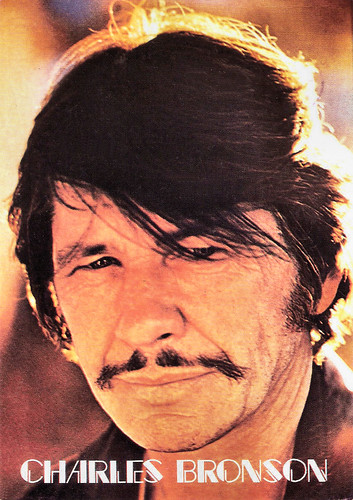
French postcard by Delta-Productions, Saint-Jean-de-Vedas, no. R53.

Italian postcard by Cineteca Bologna, 2007. Photo: A. Novi / Cineteca di Bologna. Publicity still for C'era una volta il West/Once Upon a Time in the West (Sergio Leone, 1968).
The mute and morbid assistant to Vincent Price
Charles Bronson was born Charles Dennis Buchinsky, in Ehrenfeld, Pennsylvania, in 1921. He was the 11th of 15 children of struggling Roman Catholic parents. His mother, Mary (Valinsky), was born in Pennsylvania, to Lithuanian parents, and his father, Walter Buchinsky, was a Lithuanian immigrant coal miner. The family had Lipka Tatar roots (Lipka Tatars were a group of Tatars who originally settled in the Grand Duchy of Lithuania at the beginning of the 14th century). His father died when Charles was 10. He learned to speak English when he was a teenager; before that, he spoke Lithuanian and Russian. Charles completed high school, and at 16 he followed his brothers into the mines to support the family. He was paid $1 for each ton of coal that he mined and volunteered for perilous jobs because the pay was better.
Charles was drafted into the army in 1943 and assigned to the Air Corps. At first, he was a truck driver but was later trained as a bomber tail gunner and in 1945, he was assigned to a B-29. He flew 25 missions and received, among other decorations, a Purple Heart for wounds incurred in battle. After his return from the war, Bronson used the GI Bill to study art. Bronson worked at many odd jobs. While working as a set designer for a Philadelphia theatre troupe, Bronson played a few small roles and almost immediately switched his allegiance from the production end of theatre to acting. In New York, he shared an apartment with Jack Klugman while both were aspiring to play on the stage. In 1949, he moved to California, where he signed up for acting lessons at the Pasadena Playhouse. One of his teachers was impressed with the young man and recommended him to director Henry Hathaway, resulting in Bronson making his film debut in You're in the Navy Now (Henry Hathaway, 1951), with Gary Cooper.
Charles Buchinsky appeared on screen often early in his career, though usually uncredited. However, he made an impact on audiences as Igor, the mute and morbid assistant to deranged sculptor Vincent Price in the 3-D thriller House of Wax (Andre de Toth, 1953). In 1954, in the midst of the McCarthy 'Red Scare', he changed his stage name at the suggestion of his agent, who was fearful that his last name (Buchinsky) would damage his career. The name Bronson is said to be taken from the Bronson Gate at Paramount Studios, at the north end of Bronson Avenue.
His sinewy yet muscular physique got him cast in action-type roles, often without a shirt to highlight his manly frame. Bronson had a notable support part as an Indian in Apache (1954) for director Robert Aldrich. Aldrich asked him again for the Western Vera Cruz (Robert Aldrich, 1954) with Gary Cooper and Burt Lancaster. Bronson received positive notices from critics for his performances in the Western Drum Beat (Delmer Daves, 1954) with Alan Ladd, Target Zero (Harmon Jones, 1955), and Run of the Arrow (Samuel Fuller, 1957) with Rod Steiger and Sara Montiel.
Bronson had his first lead role in Gang War (Gene Fowler Jr., 1958), an inexpensive second feature released by 20th Century Fox for the drive-in crowd. He played an embryonic version of his later Death Wish persona as a mild-mannered L.A. schoolteacher who embarks upon a one-man vendetta against the murderers of his pregnant wife. Indie director Roger Corman then cast him as real-life 1930s Public Enemy number 1, George 'Machine-Gun' Kelly, in the well-received low-budget biopic Machine-Gun Kelly (Roger Corman, 1958). Bronson next scored the lead in his own TV detective series, Man with a Camera (1958-1960) as a former combat cameraman, who is now a freelance photographer in New York City, specialising in difficult and dangerous assignments.

French postcard by Editions F. Nugeron, no. Stars 62. Photo: J. Ritchie.
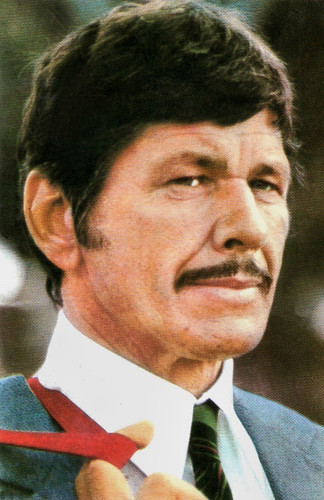
Romanian postcard by Casa Filmului Acin, 1971. Photo: publicity still for Le passager de la pluie/Rider on the Rain (René Clément, 1970).
A mysterious stranger with a harmonica, on a quest to get even
The 1960s proved to be the era in which Charles Bronson made his reputation as a man of few words but much action. Director John Sturges cast him in the smash hit Western The Magnificent Seven (John Sturges, 1960) with Yul Brynner, Steve McQueen and Horst Buchholz. He played half-Irish/half-Mexican gunslinger Bernardo O'Reilly, one of seven gunfighters taking up the cause of the defenceless. Several more strong roles followed.
Sturges hired him again for the WWII POW big-budget epic The Great Escape (John Sturges, 1963), starring Steve McQueen, James Garner and Richard Attenborough. Bronsons' expertise with tunnelling and working underground, dating from his years working in the mines, turned out to be quite helpful when playing the role of a claustrophobic Polish prisoner of war, nicknamed 'Tunnel King', Danny Velinski.
During the filming of The Great Escape (1963), Bronson was introduced to actress Jill Ireland, by her then-husband David McCallum. They fell in love and married in 1968. Ireland became his frequent co-star in such later films as Le passager de la pluie/Rider On The Rain (René Clément, 1970) with Jill Ireland, and The Valachi Papers (Terence Young, 1972) with Lino Ventura.
Once again, Bronson was back in military uniform, now as an Army death row convict, in the testosterone-filled The Dirty Dozen (Robert Aldrich, 1967). During World War II, a rebellious U.S. Army Major (Lee Marvin) is assigned a dozen military prisoners with death sentences or long terms to train and lead them into a suicide mission: a mass assassination mission of German officers. It was a massive box office success but Bronson was only the third lead. He seemed unable to make the transition to the star of major studio films in Hollywood.
European audiences had taken a shine to his minimalist acting style. Alain Delon was looking for an American actor to play his co-star in Adieu l’ami/Farewell, Friend (Jean Herman, 1968). He admired Bronson's acting, particularly in films like Machine Gun Kelly and had the producer approach him. Bronson headed to France to appear in Adieu l’ami/Farewell, Friend. The film was a massive hit in France, earning around $6 million at the box office. It was crucial to Charles Bronson's career, making him a European film star, after being pigeonholed as a supporting actor in Hollywood.
Bronson then played his best role in the classic Spaghetti Western C'era una volta il West/Once Upon a Time in the West (Sergio Leone, 1968). He was Harmoniac, a mysterious stranger with a harmonica, on a quest to get even. He joins forces with a notorious desperado (Jason Robards) to protect a beautiful widow (Claudia Cardinale) from a ruthless assassin (Henry Fonda) working for the railroad. Director Sergio Leone later called him "the greatest actor I ever worked with". Lucia Bozzola at AllMovie: "As in his "Dollars" trilogy, Leone transforms the standard Western plot through the visual impact of widescreen landscapes and the figures therein. At its full length, Once Upon a Time in the West is Leone's operatic masterwork, worthy of its legend-making title."
Now, Bronson had made a serious name for himself in European films and starred in such action-oriented films as La bataille de San Sebastian/Guns for San Sebastian (Henri Verneuil, 1968), and the Western Soleil rouge/Red Sun (Terence Young, 1971) alongside Japanese screen legend Toshirô Mifune and Ursula Andress. In Britain, he was cast in the lead of Lola (Richard Donner, 1969), playing a middle-aged man in love with a 16-year-old girl (Susan George). He also made a buddy comedy with Tony Curtis and Michèle Mercier in Turkey, You Can't Win 'Em All (Peter Collinson, 1970).

Romanian postcard by Casa Filmului ACIN.
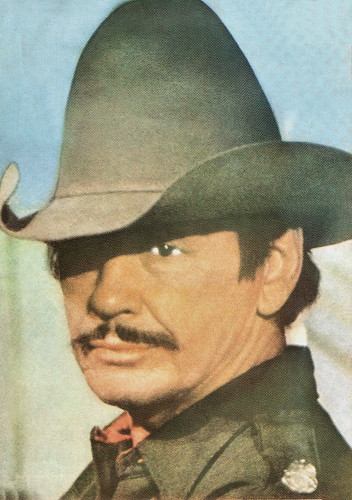
Romanian postcard by Casa Filmului Acin, 1971. Photo: publicity still for Borderline (Jerrold Freedman, 1980).
An overnight sensation in the USA after 25 years
Charles Bronson returned to Hollywood in the early 1970s to take the lead in the revenge Western Chato's Land (Michael Winner, 1972) with Jack Palance. After nearly 25 years as a working actor, he became an 'overnight sensation'. Chato's Land started a string of successful urban crime thrillers with British director Michael Winner, including the crime film The Mechanic (Michael Winner, 1972) with Keenan Wynn, Jill Ireland, and Jan-Michael Vincent, and The Stone Killer (Michael Winner, 1973) with Martin Balsam. He then scored a solid hit as a Colorado melon farmer done wrong in the Elmore Leonard adaptation Mr. Majestyk (Richard Fleischer, 1974).
However, the film that proved to be a breakthrough for both Bronson and Winner was the controversial Death Wish (Michael Winner, 1974). IMDb: "The US was at the time in the midst of rising street crime, and audiences flocked to see a story about a mild-mannered architect who seeks revenge for the murder of his wife and rape of his daughter by gunning down hoods, rapists and killers on the streets of New York City. So popular was the film that it spawned four sequels over the next 20 years."
Bronson earned good reviews for his role as the Depression-era street fighter Chaney in the directorial debut of Walter Hill, Hard Times (Walter Hill, 1975). Chaney competes in illegal bare-knuckled boxing matches after forming a partnership with the garrulous hustler Speed, played by James Coburn. It was followed by the Western Breakheart Pass (Tom Gries, 1975) with Jill Ireland, the light-hearted romp From Noon Till Three (Frank Gilroy, 1976) and the Cold War thriller Telefon (Don Siegel, 1977) with Lee Remick.
Bronson remained busy throughout the 1980s, with most of his films taking a more violent tone. Bronson jolted many critics with his forceful work as murdered United Mine Workers leader Jock Yablonski in the TV movie Act of Vengeance (John Mackenzie, 1986) opposite Ellen Burstyn, and gave an interesting performance in The Indian Runner (Sean Penn, 1991) starring David Morse and Viggo Mortensen. He surprised many as compassionate newspaper editor Francis Church in the family film Yes Virginia, There Is a Santa Claus (Charles Jarrott, 1991).
Bronson's final film roles were as police commissioner Paul Fein in a well-received trio of crime/drama TV movies, Family of Cops (Ted Kotcheff, 1995), Breach of Faith: A Family of Cops II (David Greene, 1997) and Family of Cops III: Under Suspicion (Sheldon Larry, 1999), with Sebastian Spence as his son. He retired from acting after undergoing hip replacement surgery in 1998.
Jill Ireland passed away in 1990. Charles Bronson remarried Kim Weeks in 1998. Ill health began to take its toll. Bronson suffered from Alzheimer's disease for the last few years of his life. He finally passed away from pneumonia at Los Angeles' Cedars-Sinai Medical Center in 2003. He was 81. Bronson had two children, Tony and Suzanne, with his first wife, Harriet Tendler, and a child with Ireland, Zuleika. Bronson and Jill Ireland had adopted Katrina Holden Bronson after her mother Hilary Holden died in 1983. Their adopted son, Jason, died of an accidental drug overdose in 1989.
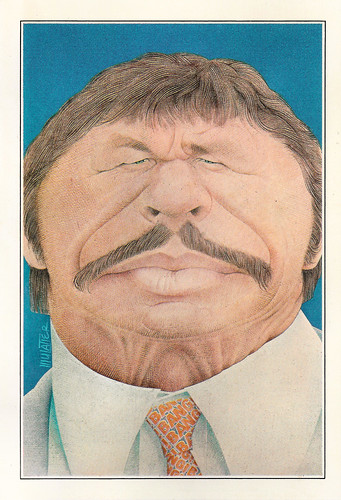
French postcard in the Les Grandes Gueules Series by Dervish International Publications, Paris, no. 116. Illustration: Mulatier - Ricord - Morchoisne.
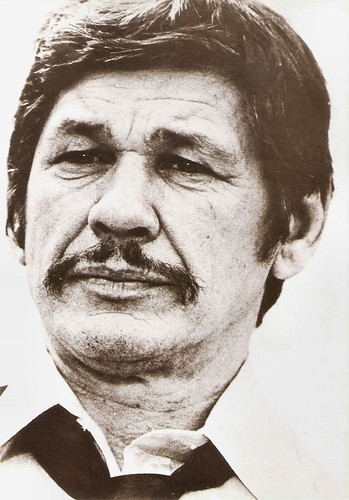
French postcard by Delta Productions, Montpellier, no. CP153.

French postcard by Ebullitions, no. 37.
Sources: Hal Erickson (AllMovie), Lucia Bozzola (AllMovie), Wikipedia and IMDb.
This post was last updated on 14 August 2023.
No comments:
Post a Comment